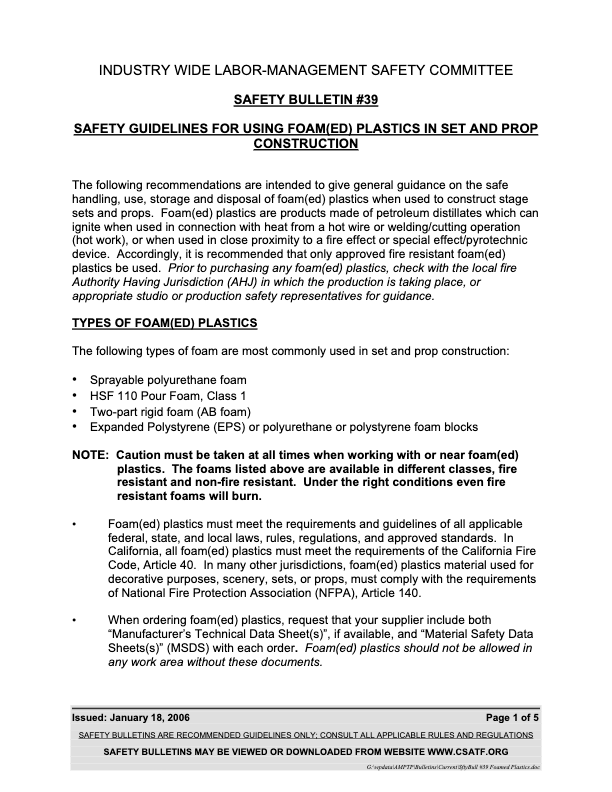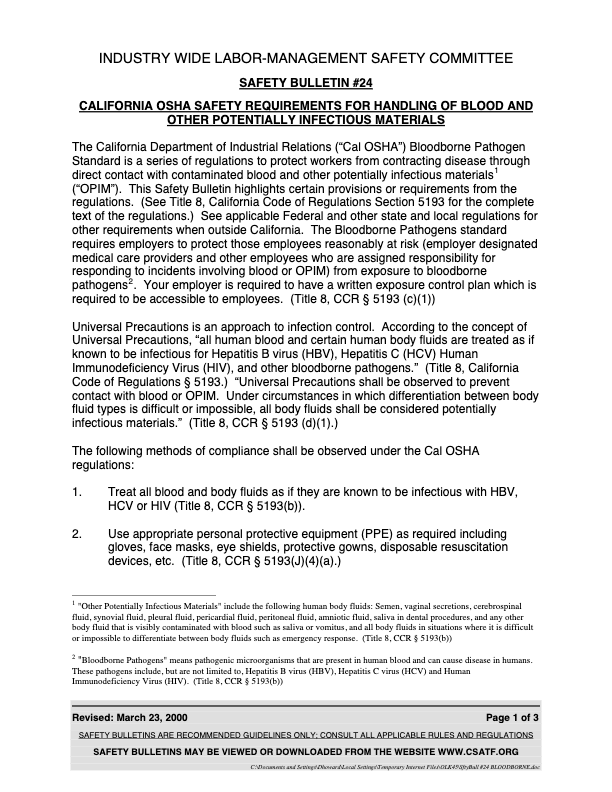Safety Bulletin

Guidelines
The following recommendations are intended to give general guidance on the safe handling, use, storage and disposal of foam(ed) plastics when used to construct stage sets and props. Foam(ed) plastics are products made of petroleum distillates which can ignite when used in connection with heat from a hot wire or welding/cutting operation (hot work), or when used in close proximity to a fire effect or special effect/pyrotechnic device. Accordingly, it is recommended that only approved fire resistant foam(ed) plastics be used. Prior to purchasing any foam(ed) plastics, check with the local fire Authority Having Jurisdiction (AHJ) in which the production is taking place, or appropriate studio or production safety representatives for guidance.
Types of Foamed Plastics
The following types of foam are most commonly used in set and prop construction:
- Sprayable polyurethane foam
- HSF 110 Pour Foam, Class 1
- Two-part rigid foam (AB foam)
- Expanded Polystyrene (EPS) or polyurethane or polystyrene foam blocks
Note: Caution must be taken at all times when working with or near foam(ed) plastics. The foams listed above are available in different classes, fire resistant and non-fire resistant. Under the right conditions even fire resistant foams will burn.
- Foam(ed) plastics must meet the requirements and guidelines of all applicable federal, state, and local laws, rules, regulations, and approved standards. In California, all foam(ed) plastics must meet the requirements of the California Fire Code, Article 40. In many other jurisdictions, foam(ed) plastics material used for decorative purposes, scenery, sets, or props, must comply with the requirements of National Fire Protection Association (NFPA), Article 140.
- When ordering foam(ed) plastics, request that your supplier include both “Manufacturer’s Technical Data Sheet(s)”, if available, and “Material Safety Data Sheets(s)” (MSDS) with each order. Foam(ed) plastics should not be allowed in any work area without these documents.
Potential Health Hazards from Working with or Around Foam(Ed) Plastics
When foam products burn they will generate dense clouds of black smoke and a variety of toxic gases, including carbon dioxide, carbon monoxide, oxides of nitrogen, and traces of hydrogen cyanide. All precautions must be taken to avoid ignition of foam(ed) plastics to prevent inhalation of potentially hazardous smoke and other injuries, such as burns.
If inhalation of potentially hazardous smoke occurs, immediately seek medical attention.
The primary hazards in working with or around foam(ed) plastics are adverse health effects from direct exposure to foam(ed) plastics and injuries caused from ignition of foam(ed) plastics. Although foam(ed) plastics can be used safely, they must be handled in accordance with the procedures designed to minimize exposure and ignition.
Exposure to Foam(Ed) Plastics
Typically, there are three primary routes of possible exposure to foam(ed) plastics and the vapors released from such products: inhalation, skin contact, and eye contact.
Foam(ed) products may contain chemicals known to produce chemical sensitivities. Individuals who know they have, or are prone to, chemical sensitivities must avoid any and all exposure to these products.
Inhalation
Airborne vapors, aerosol mists, and particulates are irritating to the respiratory tract. Symptoms of overexposure may include tightness of the chest and difficult or labored breathing. Headache, nausea, or vomiting may also occur. Exposure to higher concentrations may result in chemical bronchitis, pneumonitis, and pulmonary edema. Some individuals may become sensitized and experience severe asthma-like attacks whenever they are subsequently exposed to even minute amounts of vapor. Once sensitized, these individuals must avoid any further exposure.
Skin Contact
Although a single prolonged exposure is not likely to result in the foam material being absorbed through the skin in acutely toxic amounts, skin contact may discolor the skin and cause irritation. Skin contact may produce contact dermatitis and skin sensitization. Therefore, contact with the skin should be avoided.
Eye Contact
Direct or indirect contact with foam material may cause eye irritation, temporary blurred vision or corneal damage. Be aware that ordinary safety goggles or face masks will not prevent eye irritation from high concentrations of vapor.
General Precautions While Cutting, Carving, Sculpting, Gluing and/or Spraying
- Skin and eye protection should be used during all normal working operations. Personal protective equipment includes, but is not limited to, safety glasses, chemical worker’s goggles, chemical gloves, face shield, long-sleeve coveralls, safety shoes, or boots.
- Mechanical ventilation adequate enough to draw vapors, aerosol mists, or smoke away from an operator’s breathing zone should be provided at all work stations.
- When adequate local exhaust ventilation is not feasible, proper personal respiratory equipment must be used.
- Monitoring for airborne contaminants may be necessary.
General Precautions for Worksite, Storage and Disposal
- Due to potential fire hazard, consideration should be given during the design and pre-production of the set to ensure appropriate egress for cast and crew.
- During construction the Construction Coordinator, or other designated person, shall identify the location of exits and maintain escape routes. All escape routes must be clear and unobstructed. The First Assistant Director, or his or her designee, is responsible to ensure that cast and crew members are made aware of the designated escape routes.
- Foam(ed) plastics are combustible. Care should be taken to avoid contact with sources of ignition before, during, and after installation of all foam(ed) plastics. Smoking while working with or around foam(ed) plastics is strictly prohibited.
- Foam(ed) products and associated adhesives must be dry and cured prior to sculpting and/or shaping.
- When setting up welding/cutting operations, do not locate them in close proximity to foam(ed) plastics operations (see Hot Work on Foam(ed) Plastics).
- Working with foam(ed) plastics produces combustible dust. Keep the work area clean.
- Fire suppression devices and materials should be readily available when working with foam(ed) plastics. Only qualified individuals may use these devices.
- Do not expose foam(ed) plastics to reactive chemicals (such as solvents, petroleum products, etc.). Consult the product MSDS and Manufacturer’s Technical Data Sheet for further information.
- Since uncured AB foam can generate heat and cause fires, use care in disposal.
Application Of Two Part (AB) Foam
In addition to the “General Precautions”, the following safety guidelines should be used when working with two part (AB) foam:
- Only qualified personnel should spray AB foam.
- Application of AB foam should be scheduled when other cast and crew members are not on the stage or set.
- When using AB foam, either hand mixed or with froth packs, workers should refer to the MSDS and wear the proper personal protective equipment (PPE).
- Be aware the application process of AB foam generates heat and may increase the likelihood of fire.
- Minimize spaces between foam blocks that will be filled with AB foam. Large spaces that have been filled with AB foam have a greater likelihood of igniting when using the “hot wire” technique.
- Allow all joints time to dry and cure before cutting or shaping. A non-cured joint is a fire hazard.
- All equipment used in spraying foam should be kept clean, properly calibrated, and in good working order. Special attention should be paid to nozzles, pick-ups, and tubing.
- The drums and/or containers of AB foam components require bonding and/or grounding to prevent the build up of static electricity.
- Precaution should be taken to avoid spills when storing and using AB foam. When storing 55-gallon drums of AB foam use appropriate secondary containment. Consult the Studio Safety Representative, local Fire Authority or local Authority Having Jurisdiction (AHJ) when storing large amounts (55 gallon drums) of AB foam.
Sculpting Foam
In addition to the “General Precautions”, the following safety guidelines should be used when sculpting foam:
- Sculpting foam(ed) plastics may involve many different types of tools. Care must be taken when using sharp tools or those with moving parts to avoid injury. Be aware of others working in close proximity.
- Abrading, sawing, cutting, sanding, or other methods of sculpting foam(ed) plastics will cause dust and debris to form, which increases the potential for flammability.
- Wear appropriate PPE when necessary. Keep the work area clean by regular sweeping and disposal of dust and debris.
Hot Work on Foam(ed) Plastics
In addition to the “General Precautions”, the following safety guidelines should be used when performing hot work on foam(ed) plastics:
- Only qualified personnel should use hot wire devices.
- Hot work, which includes hot wire sculpting and welding/cutting, may require a fire department permit.
- Hot wire sculpting uses various types of electrical and heated devices. AB foam must be fully cured before sculpting with a hot wire.
- Exposed hot wire devices are heated to high temperatures. The hot wire heated elements must not be left connected and unattended.
- All equipment used in a hot wire operation must be inspected and kept in good working order at all times.
- Any handheld hot wire device should be able to be disconnected from the electrical supply at the device.
- The hot wire should be adjusted such that the wire is not visibly red.
- Hot work must not be performed within ten (10) feet of any flammable and/or combustible materials, unless approved by the AHJ.
- A fire watch should be provided during a hot work operation. Individuals assigned to fire watch duty must have fire-extinguishing equipment readily available and must be trained in the use of such equipment. If possible and safe to do so, individuals assigned to fire watch duty should extinguish spot fires and communicate an alarm in the event of a fire.
- Fire watch assignments should continue for a minimum of thirty (30) minutes after the interruption or conclusion of hot work operations.

